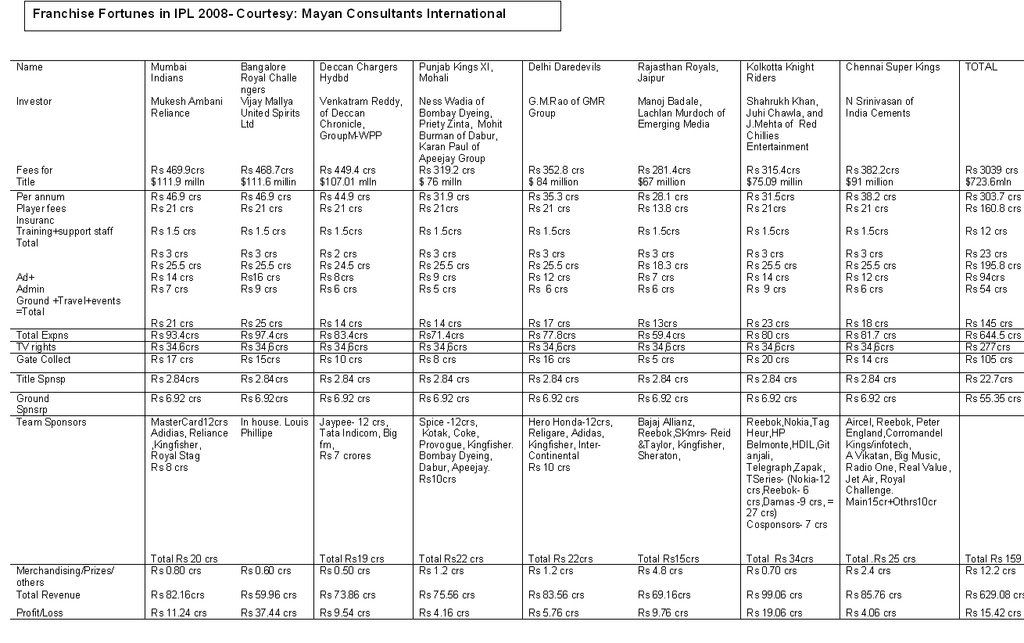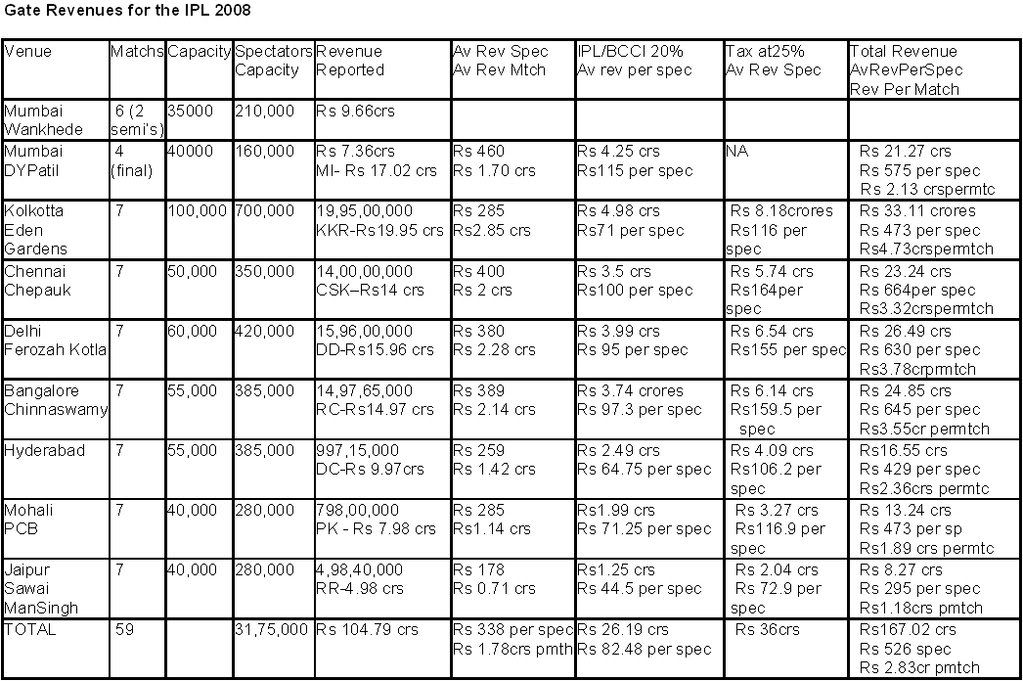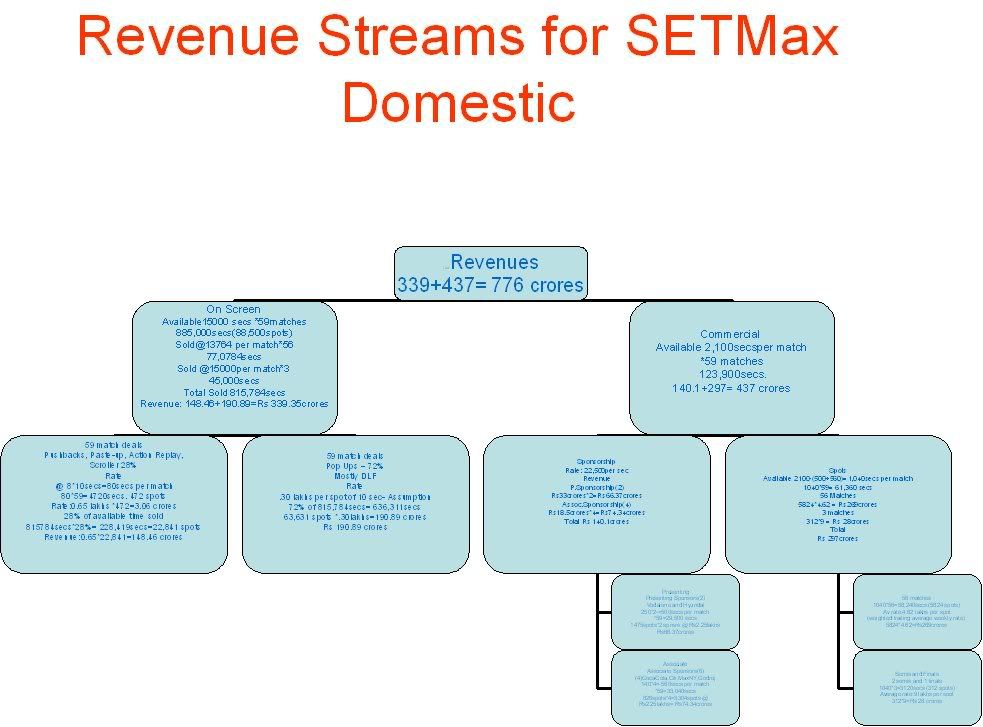Q .What is the role of BCCI and how has it contributed to the success of the IPL?
• The role of BCCI in Indian cricket needs to be understood first:
– Board of Control for Cricket in India (BCCI) is a society registered under the Tamil Nadu Societies Registration Act.
– It has set up a separate body to handle the IPL with Mr. Lalit Modi as the IPL Commissioner. Mr. Modi is an office bearer in the BCCI.
– He reports to Shri.Sharad Pawar, the Chairman of the BCCI, who is currently, the Minister for Agriculture in the Indian Government.
– Surprisingly, this society is not directly under the Government and is comprised of industrialists and politicians. But it selects and sends the national cricket team for international matches.
– It is affiliated to the International Cricket Council, which comprises of entities that manage and controls cricket in various countries such as UK, Australia, New Zealand, West Indies, South Africa, Pakistan, Sri Lanka, Bangladesh and Zimbabwe.
– BCCI has various State Cricket Associations affiliated to it which manage venues and manages cricket teams of each state.
• BCCI’s financial strength is now considerable and has proportionate clout in the international arena.
– In 1992 it had a deficit of $150,000(Rs 63lakhs).
– It has now however, increased its profits from $1.11 million (Rs 4.62 crores) in 2004-05 to $7.64 million (Rs 32 crores) in 2005-06. This 32 crores came from overall revenue of Rs 430 crores.
– Overall income for the BCCI in 2006-07 was Rs 650 crores BCCI executives say 80 per cent of that income is from broadcasting rights. The television rights as mentioned earlier include the 5 year $612 million (Rs 2,570.4crores) deal with Nimbus up to 2010 , the Zee Telefilms for $220 million (Rs 924 crores) for the same time frame.
– The BCCI has also sold the kit sponsorship to Nike for $45 million (Rs189crores) for five years through December 31, 2010.
– The team sponsorship has gone to Air Sahara for $72 million (Rs 302crores).
– Business Standard estimates that it will get another $450 million (Rs1890crores) from the sale of other rights, including hotel, travel and ground sponsorship.
– Forbes magazine attempted a valuation of the different cricket boards. According to its calculations,
– the BCCI was worth $1.5 billion, the England & Wales Cricket Board $270 million
– and Cricket Australia $225 million. The ICC was pegged much lower at $200 million. The others were Pakistan ($100 million), South Africa ($65 million), Sri Lanka ($14 million) and Bangladesh ($5 million). "There are 10 full members of ICC, but in terms of revenue India contributes more than 70% to the game," the magazine wrote. "Most sponsorships and broadcast rights come from India, and Indian tours make foreign boards rich.
– Players make or break the popularity of a game. Iconic players with superior talent drive viewer ship and the fan base. BCCI has exclusive rights to selecting and retaining the “men in blue” or the Indian cricket team. Post 1983’s World Cup success, the game and the players have been celebrities in their own right. Exclusive access to them has given it a monopoly status in one of the country’s main pastimes.
– The BCCI has several cricketers on contract. The top Indian players -- eight at last count -- get an annual retainer of $115,000. The players in Grade B (four) get an $81,000 retainer and those in Grade C (five) get $46,000. The match fee is $5,800 a test match and $3,700 for ODI matches. The contracts were revised upwards after 2006.
– Under the existing system, 26% of BCCI's gross revenues were earmarked for player payments. The Men in Blue -- the Indian team -- got 13%, domestic cricketers got 10.6%, with the remaining 2.4% going to junior cricketers.
– Indian cricket’s governing body plans to allocate Rs 55 crore (a 30 per cent increase over last year) as match fees for domestic cricketers in 2007-08, in response to the ICL threat. ( a rival league sponsored by Zee’s Subash Chandra)
– BCCI announced domestic cricketers would be paid Rs 36,000 per match day in the current financial year, from around Rs 26,000 per match day in the last fiscal. Each senior cricketer plays up to 45 match days in domestic cricket (if his team notches up a stellar performance), taking the annual match fee earnings of local players up to Rs 16.2 lakh.
– BCCI’s also runs the National Cricket Academy and such initiatives to identify talent. It has the ability to provide raw talent for the franchisees.
• The setting up of the IPL as a separate entity was one of the decisions of the BCCI. Headed by one of its office bearers, Mr Lalit Modi as its Commissioner, the IPL has a separate management team with a CEO and a Governing Council.
• The format has been prepared carefully and the rules carefully adjusted to ensure that the league is not dominated by anyone team and the matches remain exciting and unpredictable.
• Leveraging its clout and appeal it has contracted nearly 78 international and national players to form a pool for franchisees. Most of them are on “basic” contracts where the entire player fee goes to them while there are others on a “firm contract” where a minimum fee is guaranteed by IPL and any excess paid by franchisees is kept by the IPL. If more than one team is interested in the player, it is decided by an auction. Contracts are irrevocable and for 3 years and need to be paid irrespective of whether the player is in the playing 11 or on the bench. Every year there is also trading of players. While giving players a sense of security, this automatically acts as an incentive and a whip for the player in question.
• There are ‘icon’ players in each team who will be paid 15% more than the highest paid player, since they will not be auctioned. Sachin Tendulkar for Mumbai, Sehwag for Delhi, Dhoni for Chennai, Dravid for Bangalore, Ganguly for Calcutta, Yuvaraj for Punjab. For Royals and Chargers there is no icon player. This has ensured that each franchisee has a ‘star attraction’ in his team and there is an ‘anchor product’, to use a retailing term, to get in the ‘footfalls’.
• A minimum and maximum has been kept as the bandwidth for players fees. Each franchisee is expected to pay a minimum of US$3.3(Rs13.6 crores) million per annum and a maximum of US$ 5million per annum (Rs 21 crores) for the team in terms of players fees. The playing team can comprise of a maximum of 4 international players and the rest are Indian nationals. This ensures that the playing fields are level and there is no domination by anyone team which could make the match predictable and kill its main appeal which is its unpredictability.
• A rookie will pocket a minimum of 8.4 lakhs per annum, a Ranji player a minimum of Rs21 lakhs per annum and ICC ranked players from Rs 42 lakhs per annum upwards. This is sufficient incentive to bring in talent that exists in the country and create local brands that can grow into national brands. An example being Goni the fast bowler and Yousuf Pathan.
NEXT PAGE





